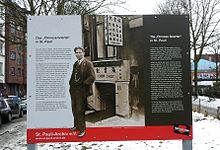Persecution of Chinese people in Nazi Germany
The article's lead section may need to be rewritten. (May 2023) |
You can help expand this article with text translated from the corresponding article in Chinese. (May 2016) Click [show] for important translation instructions.
|
Although spared from
History
Until the end of the
Starting in the 1920s, university graduates of Chinese origin emerged in Berlin, and most of them adhered to a radical
Initial persecutions

In Mein Kampf, Hitler expressed his contempt for the Chinese:
What they mostly meant by Germanization was a process of forcing other people to speak the German language. But it is almost inconceivable how such a mistake could be made as to think that a Negro or a Chinaman will become a German because he has learned the German language and is willing to speak German for the future, and even to cast his vote for a German political party. [2]
Initially the everyday life of Chinese people in Germany was unaffected by the Nazi government due to Germany's needs cheap raw materials from the Republic of China.
Later, Chinese people in Germany, some of whom adhered to a right-wing ideology, were targeted for persecution or ethnic cleansing by the Nazi government. Although most of them were not politically active, the government conducted surveillance on them. Under these circumstances, life became increasingly difficult for Chinese civilians in Germany. Beginning in 1936, Gestapo, local police and custom officers enforced unethical regulations in Hamburg's Chinatown. On January 25, 1938, the Center for Chinese (Zentralstelle für Chinesen) was founded under the control of Reinhard Heydrich, which was dedicated to controlling the size of the Chinese population.[3]
Most members of Germany's Chinese population chose to return to mainland China, but some of them chose to fight in the Spanish Civil War. According to a report composed by the Overseas Community Affairs Council, the Chinese population in Germany was reduced to 1,938 before the beginning of the Second World War.[1]

During the war
After the Chinese government declared war on Nazi Germany following the attack on Pearl Harbor in 1941, the Gestapo launched mass arrests of Chinese Germans and Chinese nationals across Germany,[4] concentrating them in the Arbeitserziehungslager Langer Morgen ("Langer Morgen Labor Camp") in Wilhelmsburg, Hamburg, and used them as forced labourers; many were tortured, bullied, assaulted, or worked to death by the Gestapo.[5]
Post-war
By the end of World War II, every Chinese restaurant in Hamburg had closed;[6] the pre-war Chinese communities in Berlin, Hamburg, and Bremen were all destroyed, and virtually no Chinese presence remained in Germany.[citation needed]
By the time the Republican government began housing German Chinese survivors, only 148 could be identified; most chose to return to mainland China, and only a few remained in Germany. Certain survivors applied for compensation from the authorities, but were denied, as the persecution was not a part of the Holocaust, per se.
In 2009, four students from the
References
- ^ ISBN 978-0-415-41868-3.
- ^ Mein Kampf by Adolf Hitler, Volume One - A Reckoning, Chapter XI: Nation and Race http://fs2.american.edu/dfagel/www/HitlerMeinKampf.html
- ISBN 978-3-937904-36-8.
- ISBN 978-0-312-17526-9.
- ^ "Gedenktafel Chinesenviertel Schmuckstraße". Wikimedia Commons. 17 March 2013. Retrieved 4 May 2016.
- ^ Gütinger 1998, p. 199
